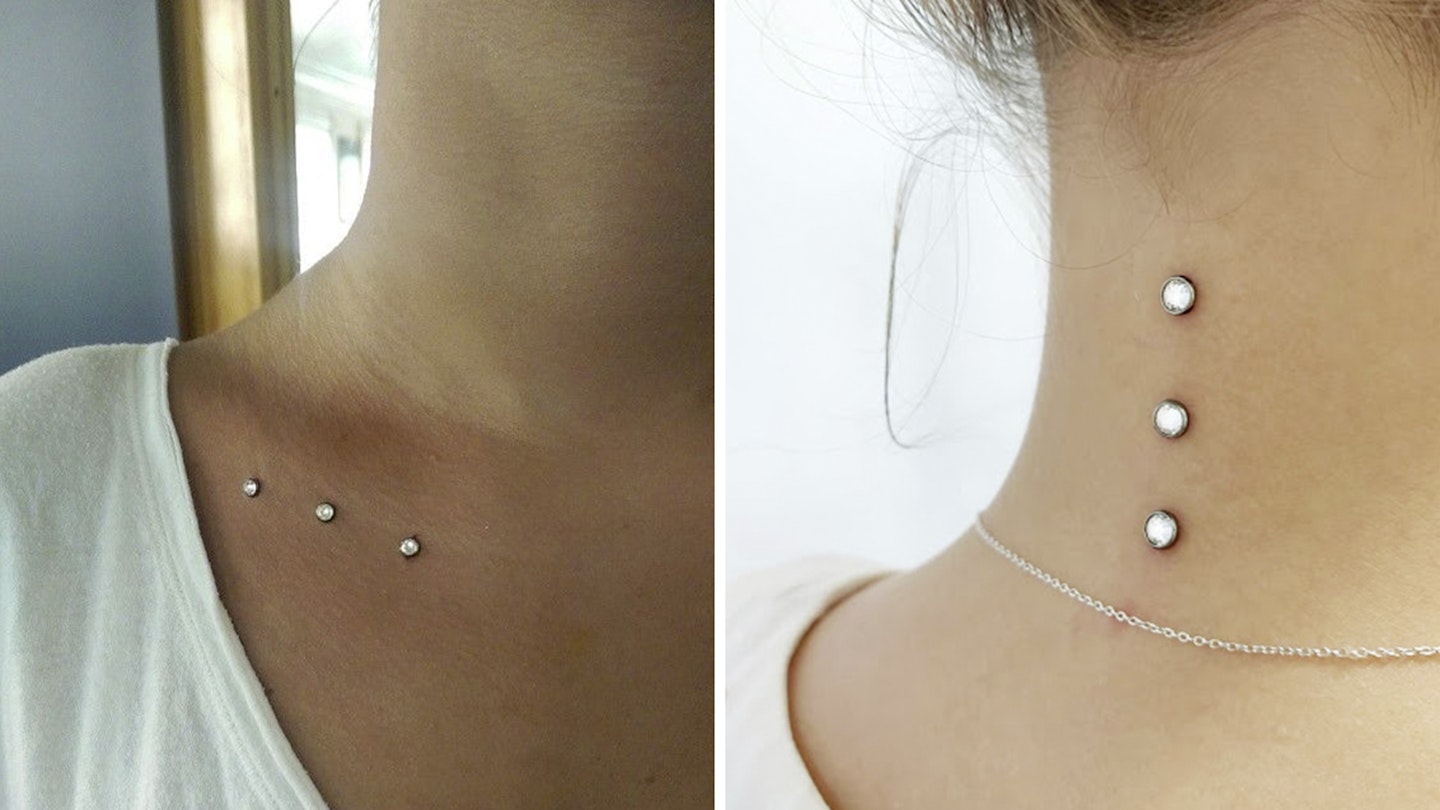Dermal piercings. Let's chat about them. Also known to those in the medical profession as transdermal implants, consider it a new-gen piercing trend that sees fans typically opt for piercings along their décolletage or somewhere on their neck or chest. But, before you even consider looking up where to get one done, it is best to read up on them and do your research first. This is because they are a bit more complex that helix’s, our septum’s and our tragus’ piercings. And the rest of the body too – including the belly, the nose, and the nipple. Luckily, we've done the hard work for you. Scroll on to find out everything you need to know about dermal piercings or microdermal piercings.
Dermal Piercings: At A Glance
Placement: A dermal piercing can be placed on any flat surface of the body - although some piercers will avoid certain areas based on healing time.
Pain: Let's say a 4/10 - often the healing can be more painful depending on the area pierced
Cost: Between £70-£100
Healing: Around three months
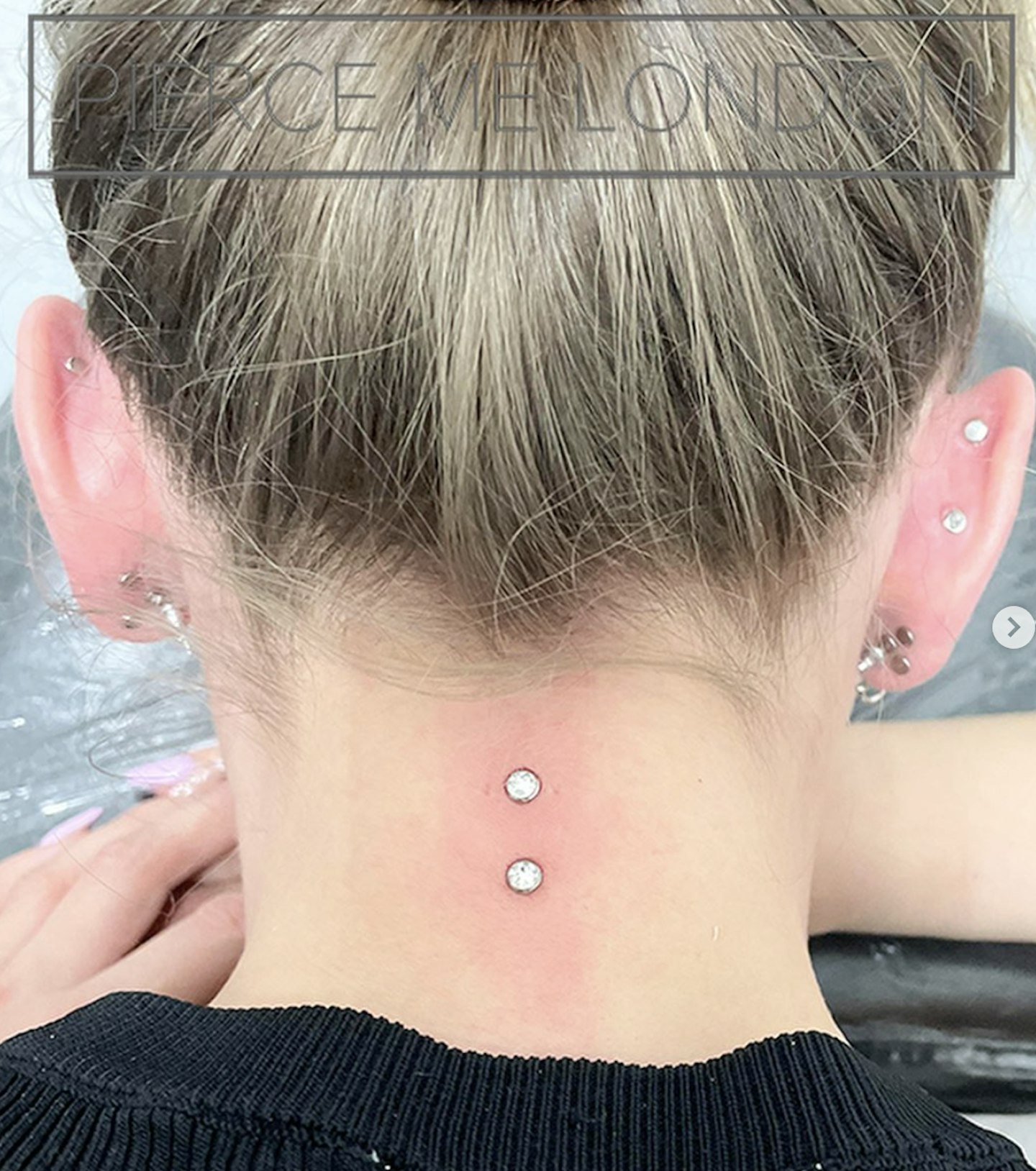
Meet the experts
-
Raph Duplay is the Owner and Head Piercer at Covent Garden's Pierce Me London.
-
Dr Sonia Khorana is a GP with a special interest in dermatology.
What exactly is a dermal piercing?
Unlike a standard cartilage or even belly button accessory, this is what’s known in the biz as a ‘single-point surface piercing’. Many argue it counts as a type of body modification.
'Microdermal piercings originated in the USA in the early 2000s and have evolved significantly in terms of design and materials,' explains Duplay. 'Microdermals are intriguing for their minimal invasiveness compared to traditional piercings. They sit just below the skin's surface and don't penetrate through to the other side, making them appear as if tiny gems or metals are embedded directly in the skin.'
Think one entry and no exit point. This means it's trickier to change, clean and care for because it doesn’t pierce through the skin, rather it’s embedded in and sits under the surface of the skin with a dermal anchor keeping it in place.
How does a dermal piercing work?
PSA to all weak-stomached readers: skip this paragraph. First, a professional piercer will sterilise the area and then use either a dermal punch on to remove a small tube of flesh, or a needle to make an L-shaped pouch, then, using dermal forceps, an anchor with either a footed or round base is inserted into the area. That's how a transdermal implant is done.
Watch: Dermal Piercing Video
What does a dermal piercing really feel like?
Does a dermal piercing (transdermal implant) hurt? Some say yes, and some say no. This is to do with a number of factors, like sensory nerve distribution, the thickness of your dermis layer and whether a dermal punch or needle is used. 'At Pierce Me London, we take great care in ensuring the piercing process is as comfortable as possible,' says Duplay. 'We use precise techniques with a flat needle to minimise discomfort.'
'I have had a few microdermals myself,' says Duplay. 'The piercing itself is not very tender and it is not a sharp sensation like traditional piercings. When the jewellery is placed inside, it feels like a lot of pressure, but I wouldn't describe it as sore.'
Piercing aficionado Lucy Hammond tells us: ‘I would really take the time to think about getting a dermal piercing because, although it doesn't hurt it will leave a scar. I don’t get regret having it done though, I’ve had two and am considering a third! My dad isn’t happy about it!’
Cost
What is the cost of a dermal piercing? A piercing can cost between £70-£100 and sometimes more depending on the area.
Jewellery
Wondering what is a dermal piercing anchor? There are 2x parts in a microdermal piercing jewellery: the anchor and the top.
'These parts can be detached from one another,' explains Duplay. 'The anchor will sit inside the body while the top will sit on the outside, resting on the skin. Each anchor is secured using implant-grade titanium for its base, ensuring safety and compatibility.'
'As aforementioned, each anchor is secured using implant-grade titanium for its base,' says Duplay. 'The decorative tops vary, available in surgical steel 316L, titanium, or gold, catering to aesthetic preferences. Our studio offers a selection of initial jewellery options for microdermals, including various gems and metal disks.'
Can you change these yourself when the piercing is healed? That's a no.
'It's crucial to have these changed by a professional piercer after the piercing has healed for at least four months due to their sensitive nature.'
1.
Dermal Top with 3mm Natural Diamond Labret Stud With 14K Solid Yellow Gold
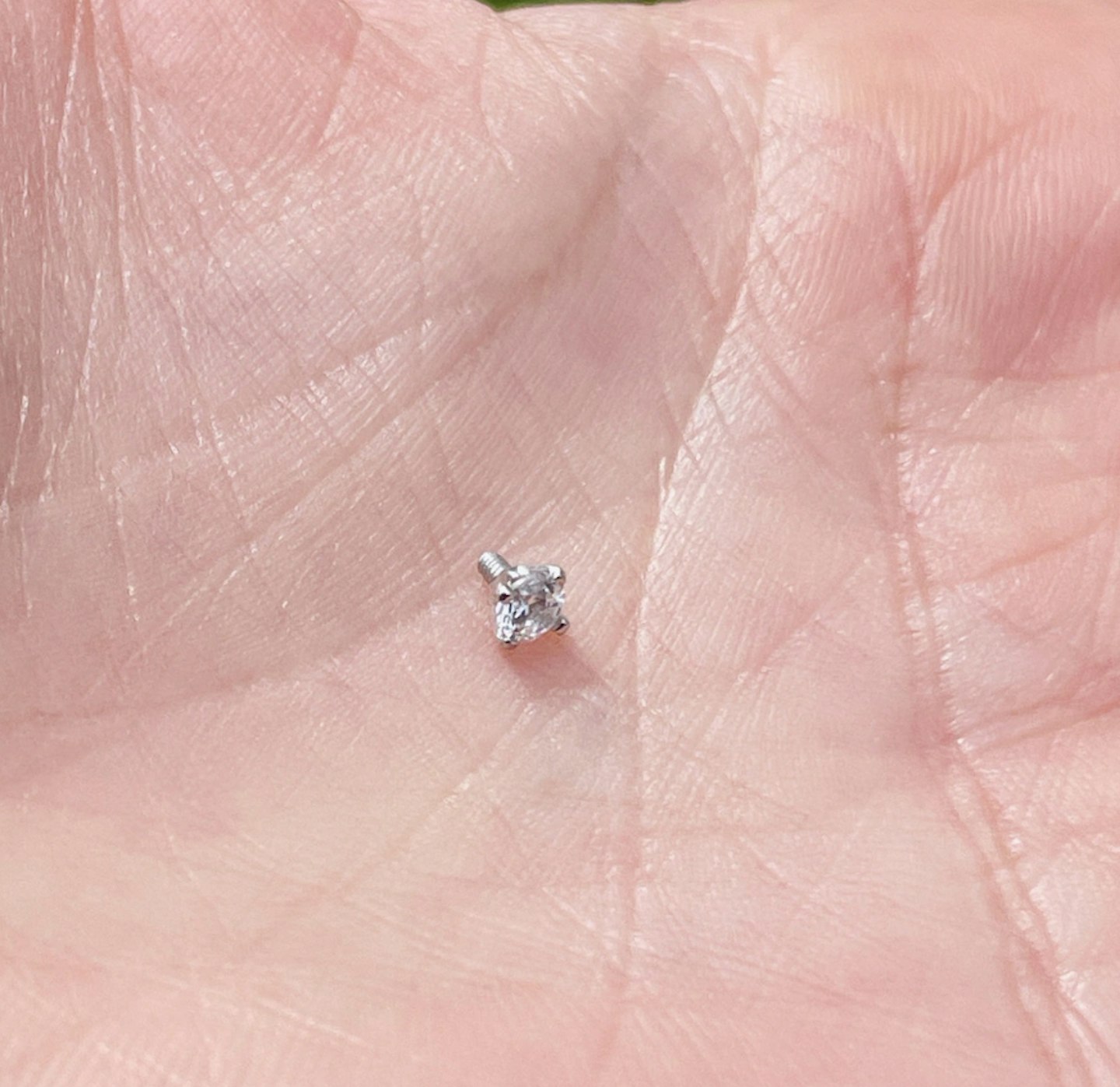
Dainty and delicate, this diamond labret stud is made with 14k solid gold. The end results? A very pretty dermal jewel that's sure to reel in the compliments.
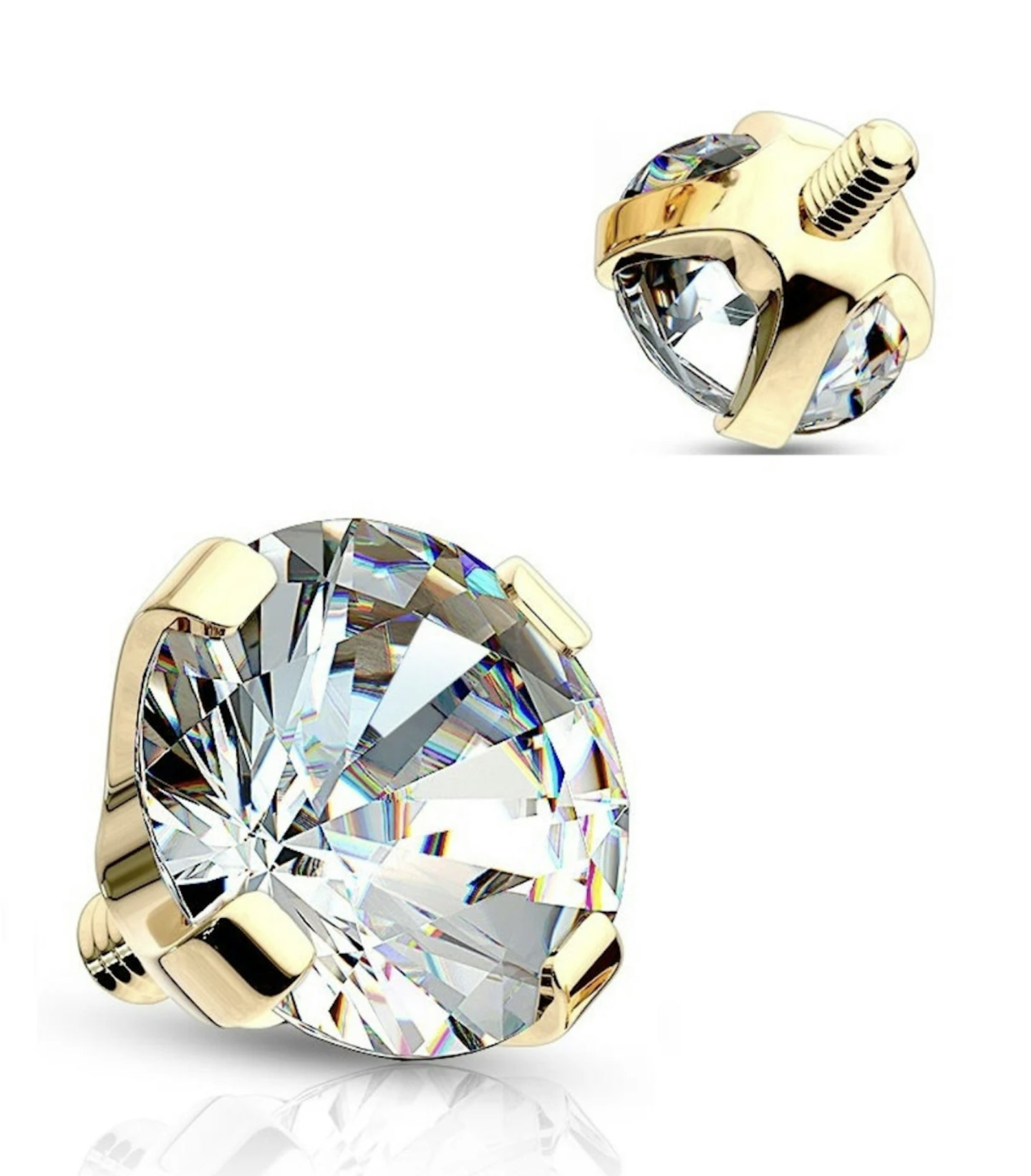
www.etsy.com
A touch of gold and a flash of diamond make this 14k solid gold gem a beautiful option. Speak to your piercer first, if this one tickles your fancy.

www.etsy.com
This amber stud adds a touch of interest - it's the perfect option for those who embrace a more boho piercing style.
How long does a dermal piercing last?
'Microdermals are temporary and can be rejected by the body over time,' explains Duplay. 'This time might vary from person to person.'
While you might not get a choice about what type of dermal base is used, there are several variations. Some are punctured with holes so that the tissue can grow in and around the piercing while others have pivoting feet that keep the piercing in place over time – FYI this is very important as these little accessories have a habit of migrating and rejecting over time (if this happens to you speak to your piercer STAT as a displaced piercing can be fixed as long as you act fast!).
Obviously, you'll need to go back to your piercer for this procedure.
Which body parts can you actually get pierced?
It's been thought that this piercing has no limits. Many have dermal piercings on their wrist, chest, face, neck, hips, back dimples, cheeks, throat, stomach, back of their neck, by their ears and even between their breasts. Ruplay advises to proceed with caution however. 'Stick to the green areas of the body map below for the best, safest results based on client comfort.'
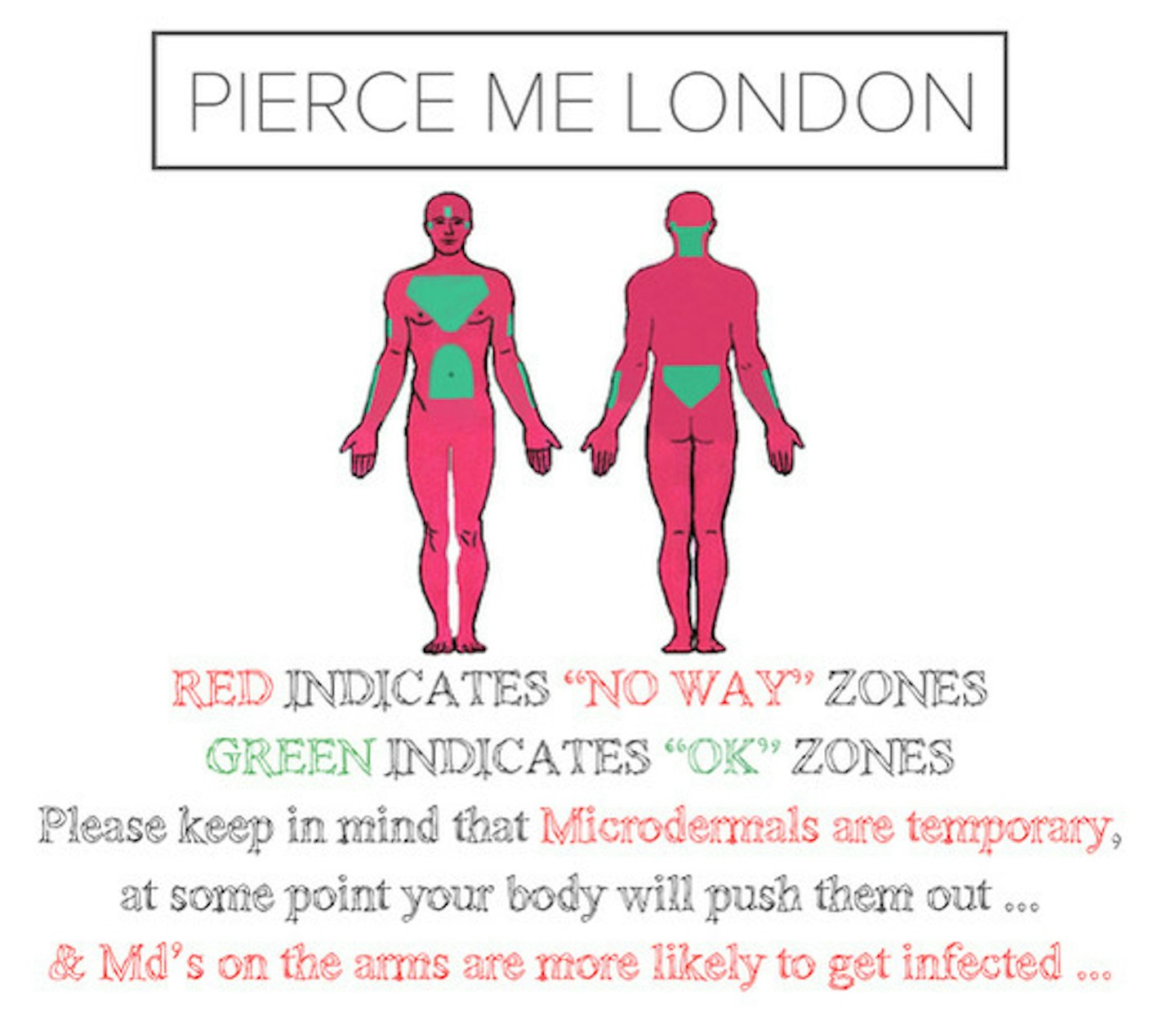
Aftercare
How do you keep a dermal piercing (transdermal implant) clean and care for it?
When you first get it done, care for it like it’s your offspring as these piercings are easy to snag, bump and tug, which can hurt like hell. It’s worth noting that even if you get through the initial months of cleaning and looking after this baby that over time your body might reject it just for the heck of it. You’ll know this is happening because it will slowly be ejected from the skin. But, to ensure it lasts as long as possible keep it (and yourself) clean, use things like antibacterial soap and only touch it with washed hands.
'Understanding aftercare is crucial,' confirms Ruplay. 'Regular cleansing and minimal contact reduce infection risks, while proper lifestyle choices like good hygiene and avoiding nicotine aid the healing process. We always stress the importance of professional follow-up for adjustments or removal to prevent complications such as hypergranulation or scarring.'
Of course, do the normal stuff, like showering and eating and sleeping, and your body will fill in the rest of the healing. Essentially the thing is a surgical incision so don’t go squeezing your luxe shower gel into the wound and making it sudsy. Consider buying a saline solution mist or liquid that you can dab on twice a day with a cotton bud with a drop of tea tree oil, and blot dry with a paper towel.
Or, if you’ve spent all your savings on the piercing itself you can make a homemade solution with actual sea salt – not the stuff from Waitrose, but the kind you find in a pet store for an aquarium. Mix the salt with water that’s been made sterile by being boiled for five minutes. Your proportions should be 1/4teaspon salt to one cup (US measurements) water. Like, the shop purchased stuff, soak the piercing twice a day a for five minutes.
If you exercise or play on a sports team you should be extra careful. Experts recommend wearing a breathable bandage and loose clothing that doesn’t put pressure on the piercing. So, if you’re planning on getting your hip bone done then wave goodbye to those Lululemon yoga pants.
Healing time
How long does a dermal piercing take to heal? 'Typically a dermal piercing heals within 2-3 months,' says Ruplay. Patience is key!
Dermal piercing removal - how does it work?
It's not a complicated procedure, but it does involve a bit of work says Duplay.
'Your piercer will work with the surrounding skin to help dislodge the anchor - think a gentle massaging motion. They will then normally use a surgical scalpel to make a small incision relative around the same size as the anchor base. Any scar tissue that has been formed will be removed with the scalpel, then your piercer will take forceps to pull the dermal piercing ancor out. It may sound painful, but you'll be numbed.'
Can you change your dermal piercing at home?
Sort of. While not recommended, you can buy a dermal holder tool or a pair of dermal forceps, which keeps your anchor in place while you twist off the top and replace it. A smart idea is to buy a magnetic dermal top set, which allows you to change the jewellery with much less faff.
Signs of infection
What do I do if my dermal piercing (transdermal implant) gets infected?
'There is a risk of infection, tissue damage, hypergranulation and scarring,' says Dr Khorana. 'Watch out for severe pain, hot-to-the-touch skin around the piercing site, yellow or green pus, severe swelling, a rash, or a bad-smelling odour - these can be signs of an infection. A red bump can also show up around the piercing site - this is a sign of hypergranulation or you could get a raised scar which is often called hypertrophic scarring or some may even experience keloids.'
If it’s in bad go to the doctor NOW. But, if it’s just a little red dedicate a little more time to your aftercare and it should start healing.
Unsure?
'Visit your piercer for a check-up on jewellery and aftercare guidelines,' advises Ruplay. 'If the jewellery is removed, the surface cells can close up, which can seal the infection inside the piercing channel and result in an abscess. Until an infection is cleared up, leave quality jewellery in!'
Scarring
Some people are more sensitive to scarring than others. If you have a family history of keloids, which is an overgrowth of sprawling scar tissue, then this is not the piercing for you. However, if it’s a hypertrophic scar that’s another issue. These tend to be flatter, smaller scars in nearish the same colour as your complexion then you can apply jojoba oil after the piercing has been removed to shrink the scar down. However, if you don’t want to scar, make sure the anchor is removed cleanly and correctly and the wound is kept clean.
So you hate it, here's what to do next...
Breathe a sigh or relief because you and get them removed and there’s a high chance you won’t scar. However, to make sure it doesn’t get infected after the anchor has been removed get a medical practitioner to take it out as the anchor has most likely melded with your tissue so it may need to be cut out. This can be painful and can cost around £10-15 to do. Plus, there’s aftercare to consider, but if you really don’t like it then this shouldn’t bother you too much.
How to pick your piercer
Obviously your piecer should be a reputable one - especially when it comes to dermal piercings which are more invasive than the typical lobe. Don't be afraid to ask questions - they should also be honest and let you know which areas to avoid. Need some further guidance? Look to the below recommend questions from the Association of Professional Piercers:
-
How long have you been piercing?
-
Where and how did you learn?
-
What do you do to keep your knowledge-base current? (ie are they taking continuing education courses on anatomy, aftercare, aseptic technique, etc.)
-
How do you ensure a hygienic environment?
Rachael Martin is Grazia’s Junior Beauty Editor. She covers all things beauty, health and wellness
